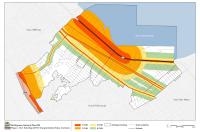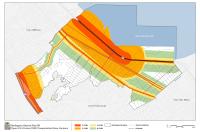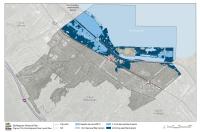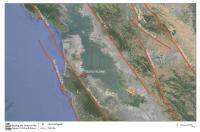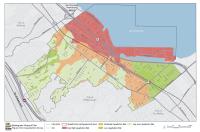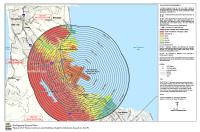Seismic and Geologic Hazards
Burlingame lies within a very seismically active zone along the Pacific Plate, with the most significant manifestations being the San Andreas Fault and Hayward Fault, both capable of generating strong earthquakes (magnitude of 6.0+ on the Richter scale). The most recent large-scale earthquake (the Loma Prieta Earthquake) occurred in 1989 and a registered magnitude of 6.9, with an epicenter located near Loma Prieta peak in the Santa Cruz Mountains. The United States Geological Survey (USGS) estimates there is a 6.4 percent probability of a 6.7-magnitude earthquake on the San Andreas Fault by 2044. The Hayward Fault is considered more probable to have a significant event, with the USGS stating a 31 percent chance for a 6.8 to 7.0 earthquake by 2042.
Potential seismic hazards in Burlingame include surface rupture, ground shaking, liquefaction, lateral spreading, and fault creep. The degree of hazard depends on the location of the seismic epicenter, the magnitude and duration of ground shaking, topography, groundwater conditions, and type of building construction. Figures CS-5 and CS-6 identify the location of seismic and geologic hazards in Burlingame, including fault lines, areas susceptible to liquefaction, and areas with steep slopes. The following goal and policies aim to minimize the risk of damage associated with geologic and seismic hazards.
Goal: CS-7
Protect people and buildings in Burlingame by reducing the risks associated with geologic and seismic hazards.
Require that any residential facility that is being increased more than 50 percent assessed value or physical size conform to current life-safety engineering standards throughout the entire structure. Encourage owners of residential buildings with known structural defects such as unreinforced garage openings, “soft story” construction, unbolted foundations, and inadequate sheer walls to take steps to remedy the problem by retrofitting buildings to meet current life-safety engineering standards. Form an ad hoc committee to investigate and describe the seismic risk posed by pre-1980 wood frame “soft story” buildings in Burlingame and to evaluate the costs and benefits of potential actions that could be pursued by the City. The ad hoc committee shall report its findings to the City Council before the end of 2020.
